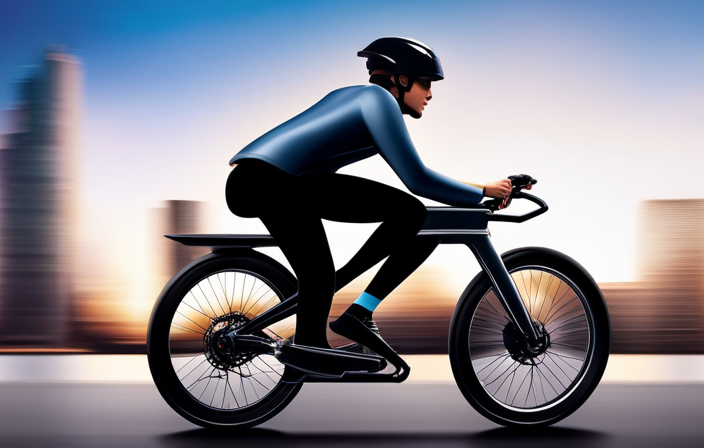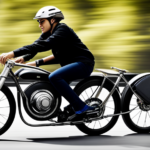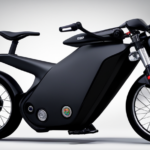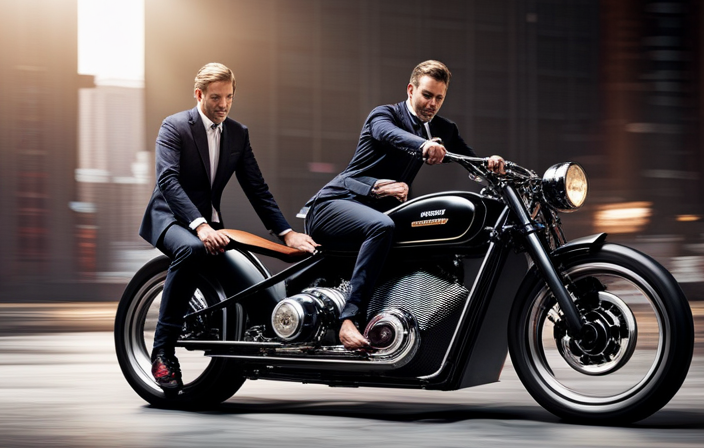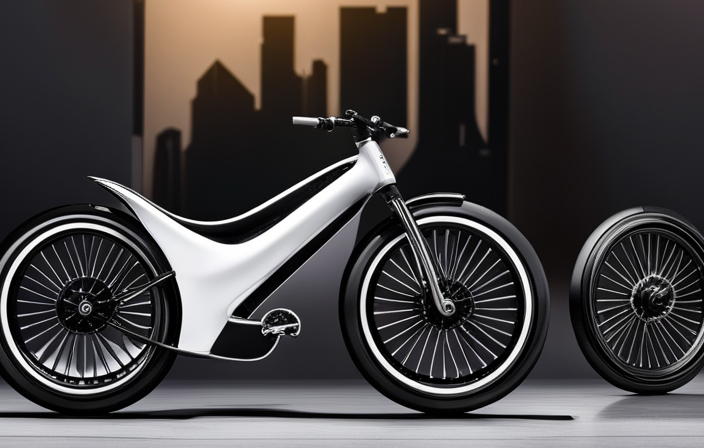Imagine flying down the road on your electric bike, with the wind rushing past you and the thrill of speed electrifying your senses.
If you’re like me, you’re constantly seeking ways to push the limits and increase your max speed. In this article, I will share my knowledge and expertise on how to achieve just that.
From optimizing your bike’s weight to upgrading your motor, I’ll provide you with technical and precise strategies to enhance your electric bike’s performance.
Get ready to unleash the full potential of your ride!
Key Takeaways
- Regularly check tire pressure and opt for tires with low rolling resistance for improved traction and faster rides
- Upgrade the motor for increased speed, torque, and overall performance, considering factors like power output and battery capacity
- Adjust riding position and remove unnecessary accessories to improve aerodynamics and reduce bike weight
- Maximize battery efficiency and upgrade the controller for improved speed and control, while also ensuring proper maintenance and lubrication of bike components.
Check Your Tire Pressure
You should make sure you’re checking your tire pressure regularly to increase your max speed on an electric bike. Maintaining the correct tire pressure is crucial for improving traction and overall performance. When the tires are properly inflated, they provide better grip on the road, allowing you to ride faster and more efficiently.
To start, you need to determine the appropriate tire pressure for your electric bike. This information can usually be found on the sidewall of the tire or in the bike’s user manual. Once you have the recommended pressure, you can use a tire pressure gauge to check the current pressure of your tires. If the pressure is too low, inflate the tires to the recommended level using a bicycle pump or an air compressor. On the other hand, if the pressure is too high, release some air until you reach the correct pressure.
Choosing the appropriate tire type is also important for maximizing your bike’s speed. Opt for tires that have low rolling resistance and are designed for road or hybrid use. These tires are specifically engineered to minimize friction and allow for smoother and faster rides.
By regularly checking your tire pressure and choosing the right tire type, you can improve traction and increase your max speed on an electric bike.
Now, let’s move on to the next section and discuss how to optimize your bike’s weight.
Optimize Your Bike’s Weight
To optimize your bike’s weight, try removing any unnecessary accessories and lighten the load as much as possible. By reducing weight, you can improve speed and overall performance. As a cyclist, I understand the importance of having a lightweight bike that can easily maneuver and reach higher speeds. To help you in your quest to reduce weight, I have created a table below highlighting some common accessories and their respective weights:
| Accessory | Weight (grams) |
|---|---|
| Rear rack | 500 |
| Fenders | 300 |
| Handlebar bag | 200 |
By removing these accessories, you can instantly shed around 1 kilogram of unnecessary weight from your bike. Additionally, consider using lightweight materials for components such as the frame, wheels, and saddle. Carbon fiber and titanium are popular choices due to their strength and low weight. Remember, every gram counts when it comes to improving speed and reducing weight.
Now that you have optimized your bike’s weight, let’s move on to the next section on how to upgrade your motor. By enhancing the power of your electric motor, you can further increase your bike’s maximum speed and performance.
Upgrade Your Motor
Upgrading your electric bike’s motor can provide numerous benefits. These include increased speed, improved torque, and enhanced overall performance. When choosing a new motor, several factors should be considered. These factors include power output, efficiency, compatibility with your bike’s battery, and the type of terrain you typically ride on.
Installing a new motor on your electric bike can be a relatively straightforward process. It involves steps such as removing the old motor, connecting the new motor, and adjusting the settings to optimize performance.
Benefits of Upgrading Your Electric Bike’s Motor
If you’re looking for a way to enhance your electric bike’s performance, consider the benefits of upgrading its motor.
Upgrading your electric bike’s motor can greatly improve its acceleration and increase its range.
Here are a few benefits of upgrading your electric bike’s motor:
-
Improved acceleration: Upgrading your motor can provide a higher power output, allowing your electric bike to accelerate faster. This means you can reach higher speeds more quickly and navigate through traffic or challenging terrains with ease.
-
Increased range: A more powerful motor can also help increase the range of your electric bike. With a higher power output, your bike will require less effort to maintain a certain speed, resulting in extended battery life and longer rides without needing to recharge.
-
Enhanced overall performance: By upgrading your electric bike’s motor, you can enjoy an overall improvement in its performance. From faster acceleration to increased range, a new motor can transform your electric bike into a high-performing machine.
Now, let’s delve into the factors to consider when choosing a new motor for your electric bike.
Factors to Consider When Choosing a New Motor
When choosing a new motor for your e-bike, it’s important to consider factors such as power output and compatibility. The motor power determines the speed and acceleration of your electric bike, while the battery capacity affects the range and overall performance. To help you make an informed decision, here is a table comparing different motors based on these factors:
| Motor Model | Power Output | Battery Capacity |
|---|---|---|
| Model A | 500W | 36V |
| Model B | 750W | 48V |
| Model C | 1000W | 52V |
How to Install a New Motor on Your Electric Bike
Installing a new motor on your e-bike can be a straightforward process with the right tools and instructions. To ensure a successful installation, here are some tips to keep in mind:
-
Prepare the bike: Before starting the installation, remove the old motor and any components that may interfere with the new motor.
-
Follow the manual: Carefully read and follow the instructions provided with the new motor. This will ensure proper installation and prevent any issues down the line.
-
Test before finalizing: Once the motor is installed, test it to make sure it functions correctly. Check for any unusual noises or vibrations.
-
Troubleshoot if needed: If you encounter any issues during the installation process, refer to the troubleshooting section in the manual or seek assistance from the manufacturer.
Improve Your Aerodynamics
To increase your max speed on an electric bike, try adjusting your riding position to improve your aerodynamics. By optimizing your body’s posture, you can significantly improve stability and reduce wind resistance, allowing you to glide through the air more efficiently.
Start by lowering your torso and tucking your elbows in, creating a streamlined position. This will help minimize the frontal area exposed to the wind, reducing the drag force acting against you. Additionally, bend your knees slightly to lower your center of gravity, improving stability at high speeds.
To further enhance your aerodynamics, consider investing in aerodynamic accessories such as a fairing or an aerodynamic helmet. These additions can further reduce wind resistance and improve your overall speed performance. Additionally, ensure that your bike’s components are properly aligned and adjusted, as misaligned parts can create unnecessary drag.
Now that you have optimized your riding position and improved your aerodynamics, let’s move on to enhancing your battery performance. By maximizing your battery’s efficiency, you can increase your electric bike’s overall speed and range without compromising on performance.
Enhance Your Battery Performance
Now that you’ve optimized your riding position and improved your aerodynamics, let’s focus on how to enhance your battery performance.
Improving battery life and increasing power output are crucial factors in achieving better performance on an electric bike. To improve battery life, it’s important to properly maintain and care for your battery. Regularly checking the battery’s charge level and ensuring it is stored in a cool and dry place can help prolong its lifespan. Additionally, avoiding extreme temperatures and charging the battery at the recommended voltage can also contribute to better battery performance.
Increasing power output can be achieved by using a high-quality battery pack with a higher voltage or capacity. This will provide more power to the motor, resulting in increased speed and acceleration. Upgrading to a more efficient motor controller can also improve power output. A controller with advanced features such as regenerative braking and variable speed control can optimize the performance of your electric bike. By upgrading your controller, you can further enhance the battery’s power delivery and overall performance.
In the next section, we will explore how upgrading your controller can take your electric bike to the next level, providing you with even greater speed and control.
Upgrade Your Controller
If you want better performance from your electric bike, consider upgrading your controller for improved speed and control. The controller is a vital component that regulates the power output from the battery to the motor.
By upgrading your controller, you can unlock the full potential of your electric bike. Here are three key benefits of upgrading your controller:
-
Increased Speed: A more advanced controller can deliver higher amperage to the motor, resulting in increased speed. With a powerful controller, you can enjoy faster acceleration and a higher top speed, making your rides more thrilling and efficient.
-
Enhanced Control: Upgrading your controller can also improve your bike’s handling and control. With advanced features like adjustable throttle response and torque control, you can fine-tune the bike’s performance to suit your riding style. This allows for smoother and more precise control, especially when navigating challenging terrains or tight corners.
-
Compatibility with Accessories: Upgrading your controller may also open up compatibility with a wider range of accessories and upgrades. For example, installing new handlebars or adjusting seat height can greatly improve your comfort and ergonomics while riding. A more advanced controller can ensure that these add-ons work seamlessly with your electric bike’s electrical system.
Lubricate Your Bike’s Moving Parts
Lubricating your bike’s moving parts will help ensure smooth and efficient operation. By reducing friction, you can improve efficiency and maximize the speed of your electric bike. Proper lubrication is crucial in maintaining the longevity and performance of your bike.
To start, apply a high-quality lubricant to the chain, ensuring it is evenly distributed. This will reduce friction between the chain and the gears, allowing for smoother pedaling and improved power transfer. Additionally, don’t forget to lubricate other key components such as the derailleurs, shifters, and cables. These moving parts also benefit from reduced friction, resulting in better overall performance.
Regularly cleaning and lubricating your bike will not only improve its efficiency but also prevent premature wear and tear. Moving on to the next section about adjusting your gearing, it is essential to find the right gear ratio that suits your riding style and terrain.
Adjust Your Gearing
To ensure smooth shifting and optimal performance, you should adjust your gearing according to your riding style and the terrain you’ll be riding on. Adjusting your gearing can have a significant impact on your electric bike’s ability to increase speed. By making gear ratio adjustments, you can optimize the power transfer from your motor to the wheels, allowing you to go faster with less effort.
Firstly, it’s important to understand the concept of gear ratios. A lower gear ratio means that the front chainring is smaller than the rear cassette, providing more torque for uphill climbs and slower speeds. On the other hand, a higher gear ratio means a larger front chainring and a smaller rear cassette, allowing for higher speeds on flat terrain and descents.
To increase your max speed, you’ll want to shift into a higher gear ratio. This will allow you to maintain a higher cadence while still generating enough power to propel yourself forward. Experiment with different gear combinations to find the optimal ratio for your riding style and the terrain you’ll be covering.
By adjusting your gearing, you can effectively increase your electric bike’s speed potential. However, it’s important to note that high gear ratios may require more effort to pedal, especially on steep inclines.
In the next section, we’ll discuss how reducing drag can further enhance your bike’s speed and performance.
Reduce Drag
Reducing drag is essential for improving your bike’s performance and increasing your speed. When it comes to riding your electric bike, there are a few key factors to consider in order to improve wind resistance and reduce the drag that slows you down.
One important aspect is choosing suitable clothing. Opt for tight-fitting apparel that minimizes air resistance. Loose clothing can act as sails, catching the wind and slowing you down. Additionally, consider wearing aerodynamic helmets and sunglasses to further reduce drag.
Another way to reduce drag is to ensure that your bike is properly maintained. Keep your tires inflated to the recommended pressure to minimize rolling resistance. Lubricate your chain regularly to reduce friction. Additionally, check and adjust your brakes. Brakes that are rubbing against the wheel can create unnecessary drag, so make sure they are properly aligned and not causing any resistance.
By reducing drag through appropriate clothing choices and proper bike maintenance, you can significantly improve your bike’s performance and increase your speed.
Now, let’s move on to the next step: checking and adjusting your brakes.
Check and Adjust Your Brakes
Having properly functioning brakes on your electric bike is crucial for your safety and the overall performance of your ride. Brakes that are not adjusted correctly can lead to reduced stopping power, increased wear on brake pads, and potential accidents.
In this discussion, I will explain the importance of properly functioning brakes and provide step-by-step instructions on how to adjust your electric bike’s brakes to ensure optimal performance.
The Importance of Properly Functioning Brakes
Properly functioning brakes are crucial for increasing the max speed on an electric bike. When it comes to riding at high speeds, you need brakes that can provide reliable and responsive stopping power. Here are three reasons why proper brake maintenance and brake pad replacement are essential:
-
Safety: Maintaining your brakes ensures that they are in good working condition, allowing you to stop safely and quickly when needed.
-
Performance: Worn-out brake pads can reduce stopping power and increase braking distance, hindering your ability to achieve maximum speed.
-
Longevity: Regularly checking and replacing brake pads helps to prevent damage to other brake components, extending the lifespan of your braking system.
With the importance of properly functioning brakes in mind, let’s now delve into how to adjust your electric bike’s brakes to ensure optimal performance.
How to Adjust Your Electric Bike’s Brakes
When adjusting your electric bike’s brakes, it’s important to ensure they are responsive and provide reliable stopping power. To optimize brake performance and address common brake issues, follow these steps:
| Problem | Solution |
|---|---|
| Spongy brakes | Bleed the brake system to remove air bubbles |
| Brake pad wear | Replace worn brake pads |
| Brake noise | Clean the brake surface and adjust pad alignment |
| Inconsistent braking | Check and adjust cable tension |
Use a Higher Assist Level
To increase your max speed on an electric bike, try cranking up the assist level. The assist level determines how much power the motor provides while you pedal. By selecting a higher assist level, you can take advantage of the full potential of your electric bike’s motor and reach higher speeds. However, it’s important to keep in mind that using a higher assist level may drain your battery faster.
In addition to adjusting the assist level, another factor that can affect your max speed is tire pressure. Maintaining the proper tire pressure is crucial for optimal performance. When the tire pressure is too low, you may experience increased rolling resistance, which can slow you down. On the other hand, if the tire pressure is too high, it can lead to a harsh ride and decreased traction. It’s recommended to regularly check your tire pressure and inflate them to the manufacturer’s recommended PSI.
By increasing the assist level and ensuring proper tire pressure, you can maximize the speed potential of your electric bike. However, it’s important to remember that speed should never compromise safety. Always ride responsibly and within your comfort zone.
To keep your bike well-maintained and further enhance its performance, there are additional steps you can take.
Keep Your Bike Well-Maintained
When it comes to keeping your bike in top shape, regular cleaning and inspection are essential. By regularly cleaning your bike, you can remove dirt, grime, and debris that can affect its performance and longevity.
Additionally, performing basic bike maintenance such as checking tire pressure, lubricating the chain, and adjusting brakes ensures that your bike operates smoothly and safely.
Regular Cleaning and Inspection
Regularly cleaning and inspecting your electric bike can help increase its max speed. By keeping your bike well-maintained, you can improve motor performance and extend battery life.
Start by cleaning the bike thoroughly, removing any dirt, dust, or debris that may have accumulated. Pay close attention to the motor and battery areas, ensuring they are free from any obstructions.
Next, inspect all the components, such as the chain, gears, and brakes, for any signs of wear or damage. Replace any worn-out parts immediately.
Additionally, check the tire pressure regularly and adjust it as needed to ensure optimal performance.
By maintaining your electric bike, you can prevent any potential issues that may hinder its speed and performance.
Now, let’s move on to learning how to perform basic bike maintenance.
How to Perform Basic Bike Maintenance
By keeping your bike well-maintained, you can improve its overall performance and extend its lifespan. One crucial aspect of bike maintenance is optimizing the battery. To do this, start by regularly inspecting the battery for any signs of damage or wear. Clean the battery terminals and connectors to ensure a proper connection. Additionally, make sure to charge the battery fully before each ride and avoid overcharging. It’s also essential to store the battery in a cool and dry place when not in use.
By following these steps, you can maximize the battery’s efficiency and increase the distance it can power your electric bike.
Now, let’s explore another way to enhance your bike’s speed and performance: upgrading your wheels.
Upgrade Your Wheels
To increase your max speed on an electric bike, you should consider upgrading your wheels. Upgrading your wheels can improve stability and increase traction, allowing you to ride faster and with more confidence. When choosing new wheels, there are a few key factors to consider:
| Factor | Description | Example |
|---|---|---|
| Material | Choose lightweight materials like carbon fiber or aluminum alloy | Carbon fiber |
| Rim depth | Deeper rims can improve aerodynamics and reduce drag | 50mm |
| Tire width | Wider tires provide better grip and stability | 25mm |
| Hub type | High-quality hubs with smooth bearings can reduce rolling resistance | Ceramic bearings |
Practice Proper Riding Techniques
Remember, it’s essential to practice proper riding techniques in order to optimize your performance on an electric bike. To improve speed control, mastering the art of braking is crucial. When approaching a turn or needing to slow down, smoothly apply both brakes simultaneously to evenly distribute the stopping power. Avoid using only the front brake, as this can cause the bike to tip forward and potentially lead to an accident.
Additionally, optimizing your body position plays a significant role in maximizing speed. While riding, maintain a low and aerodynamic stance by bending your elbows, keeping your back straight, and tucking in your knees. This reduces wind resistance and allows for a more efficient transfer of power from your legs to the pedals.
By practicing these techniques, you will be able to enhance your speed control and overall performance on your electric bike.
Now, let’s transition to the next section where we will consider legal and safety limits.
Consider Legal and Safety Limits
When riding, it’s important to be aware of and adhere to the legal and safety limits to ensure a safe and enjoyable experience.
Electric bikes have become increasingly popular, but it’s crucial to understand the legal limits that govern their use. In many jurisdictions, electric bikes are classified as bicycles as long as they meet certain criteria, such as a maximum speed limit and motor power output. These legal limits may vary depending on where you are riding, so it’s essential to familiarize yourself with the specific regulations in your area.
In addition to legal limits, it’s important to take safety precautions when riding an electric bike. Wearing a helmet is a must to protect your head in case of an accident. It’s also important to follow traffic rules and signals, just like any other cyclist. Be aware of your surroundings, anticipate potential hazards, and maintain a safe distance from other vehicles on the road. Additionally, make sure your electric bike is in good working condition by regularly checking the brakes, tires, and lights.
Frequently Asked Questions
Can I use a regular bike chain on an electric bike?
Yes, you can use a regular bike chain on an electric bike. Most electric bikes are compatible with standard bike chains, as the drivetrain components are similar to those found on regular bikes.
However, there are alternatives to regular bike chains that can enhance performance. For example, some electric bike riders prefer using a higher quality chain or even a belt drive system, which can provide smoother and more efficient power transfer.
How often should I charge the battery of my electric bike?
I charge my electric bike battery based on the recommended charging frequency to ensure optimal battery lifespan. The charging frequency depends on the type of battery used in the electric bike.
Typically, it is advised to charge the battery after every ride or once it reaches a certain level of discharge. This helps maintain the battery’s performance and extends its overall lifespan, ensuring I can enjoy my electric bike for a longer period of time.
Is it possible to upgrade the battery capacity of my electric bike?
Upgrading the battery capacity of an electric bike is a game-changer when it comes to increasing acceleration speed. By boosting the motor capacity, you’ll experience a surge of power that will have you zooming past everyone else on the road.
With this upgrade, you’ll be able to achieve incredible speeds and leave your fellow riders in the dust.
Are there any legal speed limits for electric bikes?
There are legal speed limits for electric bikes, although they vary by country and region.
The benefits of pedal assist on electric bikes are numerous. It allows riders to go faster with less effort, making longer rides more enjoyable.
When discussing the different types of electric bike motors available, there are typically two options: hub motors, which are located in the wheels, and mid-drive motors, which are located near the pedals. Each type has its own advantages and disadvantages.
What are the safety precautions I should take when riding at higher speeds on an electric bike?
When riding at higher speeds on an electric bike, safety gear is crucial. I always make sure to wear a helmet, gloves, and protective clothing to minimize the risk of injury.
Additionally, handling corners properly is important. I lean into the turn and apply gentle pressure to the handlebars, maintaining a balanced position. This allows for better control and reduces the chances of losing control or skidding.
Conclusion
In conclusion, increasing the max speed on an electric bike requires a combination of factors.
By checking tire pressure, optimizing bike weight, upgrading the motor, improving aerodynamics, enhancing battery performance, and maintaining the bike, riders can experience a boost in speed.
Upgrading the wheels and practicing proper riding techniques further contribute to a faster ride. However, it is important to consider legal and safety limits when pushing the speed boundaries.
Remember, Rome wasn’t built in a day, and similarly, enhancing your bike’s speed takes time and effort.
